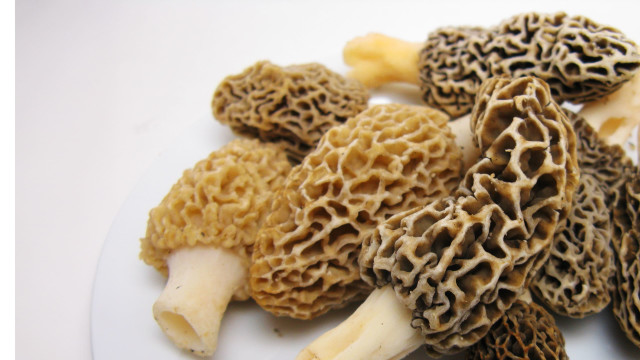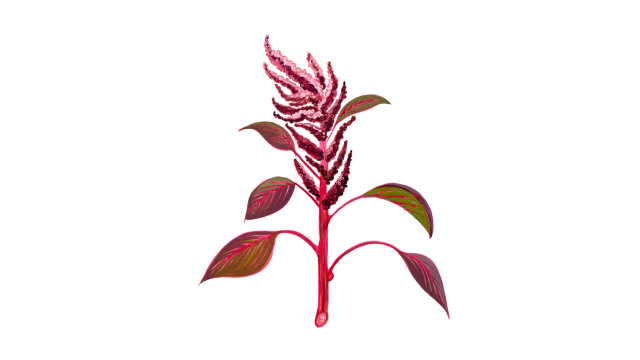Dia(spore)ic Cooking

I have just blown my mother’s mind. A few minutes ago, we foraged some ripe-to-bursting Jamaica plums (Spondias purpurea) on a nature trail in her South Florida condo complex and debated whether they would taste as sweet as their yellow-skinned brethren back home in Jamaica.* Now the conversation in her kitchen has turned to wild amaranth.
“You’re telling me callaloo, our callaloo, just grows out of the ground up there in the frozen north?”
“Only once Massachusetts has thawed, and a slightly different species than what Mamma grew, but basically, yeah.”
Callaloo calling
We are talking about callaloo because its briny aroma permeates my mother’s condo now just as it did on the Saturday mornings of my childhood, when Bob Marley sang plaintively on the stereo about guava jelly, and “back home.” The land, the meals with our entire family were on everyone’s minds.
Sometimes this savory preparation of greens (a bit like collards) was served alongside ackee and saltfish, or, depending on what was available at the Caribbean market, it might be fried breadfruit. (Delicious, but still not as good as breadfruit roasted over coals in Mamma, my grandmother’s firepit).
On this morning, though, the callaloo stands alone. Over the course of my two-week vaccination celebration visit, I’ve been cooking nothing but heavy dishes for my mother. A rotisserie chicken made of butter. Cassoulet-like white bean stew. A shepherd’s pie with minced sirloin and mushroom gravy.
Now our bodies have told us that all good things must come to an end, so we’ve opted for the simplicity of callaloo. My visit to South Florida is ending, too, which neither of us feels much like celebrating. This also means I have to say goodbye to windfall mangoes and other subtropical forageables for now.
A eureka moment
As we fork the stewed greens onto hard dough bread and eat, I have a sudden, clear vison, a eureka moment. “Black trumpet mushrooms would go really well in this, Mommy.”
She stops chewing. An ambiguous look settles across her face. Time was, my mother would have pshawed this, chalking my irreverence for family tradition up to my immigrant-baby nerve. But the truth is, I’ve made a mushroom lover out of her, sneaking their vitamin- and fiber-packed deliciousness into our meals together whenever I can. I’ve even insinuated them into her diet from afar: when there was talk of Vitamin D maybe being a natural way to combat COVID-19, I shipped her sundried “steaks” of hen-of-the-woods, which she cooked up and wolfed down. (Drying mushrooms in the sun can up their D dosage.) “I didn’t know fungus could taste that good!” she’d enthused over the phone.
But here and now, she responds to my impertinent edit of a family recipe that wasn’t broke with “Whatever you say, girl.” Allow me to translate my mother for you: “The little troublemaker may or may not be right about this, but regardless I’ll probably get free mushrooms if I go along with it.”
Troublemaking recipes
“Troublemaking” in family recipes — that is, adapting them to one’s new home — sometimes results in new categories of cuisine. One such immigrant modification can be seen in plazas near my mother’s condo: numerous Viet-Cajun seafood boil restaurants fusing two traditions together to make something perfect and delicious in its own right. Necessity (whether born of colonialism’s violence or mere neighborliness) can bring cuisines together, as proximity can make cousins out of non-blood relations.
In a talk on migration in April 2021, Mojave poet and bona fide genius Natalie Diaz spoke of how migrants to a region can practice indigeneity by learning and honoring the land they live with. Knowing what you can eat that springs from the ground you walk every day is one facet of this learning process. This can be especially meaningful for those of us who’ve come from elsewhere, since figuring out how to make your grandmother’s recipe with unaccustomed fruits honors both the land of origin and one’s adopted home.
A few days before we had callaloo, I was sprawled on the rug with a mushroom guide. As I looked back and forth from Boletes of Eastern North America to the red-capped, blue-staining mushroom in my hand, my mother offhandedly dropped some knowledge that blew my mind: “Back home, mushrooms have two names, junjo or duppy umbrella.” In Jamaican patois, a “duppy” is a ghost or spirit (see the Marley song “Duppy Conqueror”), so “duppy umbrella” is as whimsical as “toadstool,” if a little more eerie. Anyway, her comment gave me a cute name for the recipe that follows.
Midsummer in New England is the perfect time to forage both amaranth, Amaranthus palmeri, and black trumpets, Craterellus fallax, but in other regions you might have to figure out local substitutes — which is half the fun.
RECIPE | Callaloo with Duppy Trumpets
*Reader, the wild plums weren’t as sweet as their Jamaican counterparts, but that didn’t stop us from reaching for another and then another.
Key Takeaways
- Adapting recipes teaches flexibility.
- It creates new traditions of Wholistic Wellbeing.
- It helps with grounding in your environment.







